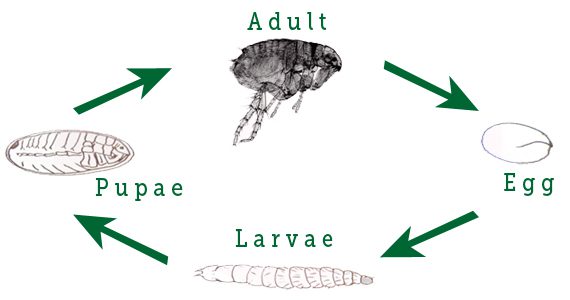Fleas can become a huge problem if not dealt with. You often hear prevention is better than cure – and treating fleas is no different. Some flea treatments not only control fleas on your animal but also help to control fleas in your environment. With so many products on the market it can be difficult to decide which product to use. Give the clinic a ring, or drop in for a visit, and let us help you find the best flea control treatment to suit you and your pet’s needs.
Below are a few interesting flea facts…
- Fleas pass through a complete life cycle of four stages.
- Completion of the life cycle from egg to adult varies from two weeks to eight months.
- Normally the female flea lays about 15 to 20 eggs per day up to 600 in a lifetime. Usual hosts for fleas are dogs, cats, rats, rabbits, mice, opossums, chickens, and humans.
- Eggs are loosely laid in the hair, and drop out where the pet rests, sleeps or nests (rugs, carpets, upholstered furniture, cat or dog boxes, kennels, sand boxes, etc.) Eggs hatch in two days to two weeks into larvae found indoors in floor cracks & crevices, along baseboards, under rug edges and in furniture or beds. Outdoor development occurs in sandy gravel soils (moist sand boxes, dirt crawlspace under the house, under shrubs, etc.) where the pet may rest or sleep.
- Larvae are blind, avoid light, pass through three larval stages and take a week to several months to develop.
- Their food consists of digested blood from adult flea feces, dead skin, hair, feathers, and other organic debris. (Larvae do not suck blood.) Pupa mature to adulthood within a silken cocoon woven by the larva to which pet hair, carpet fiber, dust, grass cuttings, and other debris adheres.
- In about five to fourteen days, adult fleas can emerge or may remain resting in the cocoon until the detection of vibration (pet and people movement), pressure (host animal lying down on them), heat, noise, or carbon dioxide (meaning a potential blood source is near).
- Most fleas survive the winter in the larval or pupal stage and grow best during warm, moist winters and spring.
- Adult fleas cannot survive or lay eggs without a blood meal, but may hibernate from two months to one year without feeding.
- There is often a desperate need for flea control after a family has returned from a long vacation. The house has been empty with no cat or dog around for fleas to feed on. When the family and pets are gone, flea eggs hatch and larvae pupate. The adult fleas fully developed inside the pupal cocoon remains in a kind of “limbo” for a long time until a blood source is near. The family returning from vacation is immediately attacked by waiting hordes of hungry fleas. (In just 30 days, 10 female fleas under ideal conditions can multiply to over a quarter million different life stages.)
- Completely developed adult fleas can live for several months without eating, as long as they do not emerge from their cocoons.
- Newly emerged adult fleas live only about one week if a blood meal is not obtained.
- Optimum temperatures for the flea’s life cycle are 70°F to 85°F and optimum humidity is 70 percent.
Breaking the cycle with an Insect Growth Regulator , not just killing the few adults is the secret to flea control.

